I'm planning to DM a mini-campaign later this year set in my Gardens of Hecate world. Titled
Monstrous Births, it will consist of three or four linked games, with the player taking control of the Countess and her spirit host. I have the key points planned out. It will take place in the woods, so I'm all set as far as scenery is concerned. But I do need to craft brand new characters/monsters for the Countess to fight. There is one that I won't reveal until the final game is played. The rest will be featured here as I make them. Today I present the first handful of them:
 |
| Wolf herdsmen are hermits who live in the woods. Wolves gather around them and obey them.
They can transform themselves and others into wolves using a magic
hoop. Many of them were originally monks who secluded themselves in the forest as a
part of their penance or in order to meditate, and mysteriously went feral in the process. They shun the company of fellow man. |
 |
| I tried to give him the same yellow eyes the wolves have, but I fear it's not really visible due to his eyes being very small. |
 |
| The pack was painted using mostly washes and glazes on top of a white undercoat. I looked at photographs of the real life animals and tried to imitate the colour patterns on their fur. There are only two poses among the six, but I think I managed to avoid the clone look. These minis can double as wolves for Frostgrave, which is great. |
Inspiration
The idea for this came once more from folklore. In northern Croatia and neighbouring Slovenia, vučji pastir/volčji pastir is a person who is the master of all wolves in an area. He appears as an old man in rags or in the shape of a wolf. He organises pack gatherings where he assigns each wolf his prey for the upcoming season. Vučji pastir can transform into a wolf by jumping through a hoop or by rolling on the ground. Legends usually speak of poachers or shepherds who eavesdrop on a pack gathering from on top a tree, which ends in them getting spotted and transformed into a wolf for a number of years as punishment. Similar figures exist in folklore of many other European peoples, Slavic and otherwise.
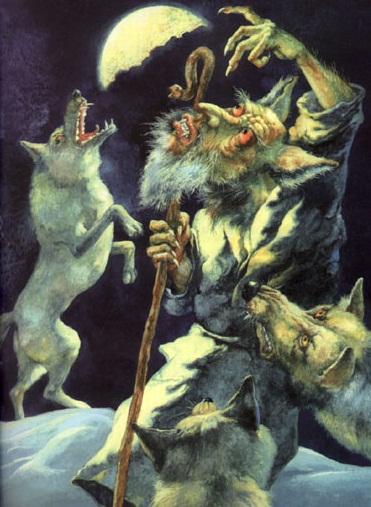 |
| Wolf herdsman artwork by Bulgarian artist Виктор Паунов (Viktor Paunov). |
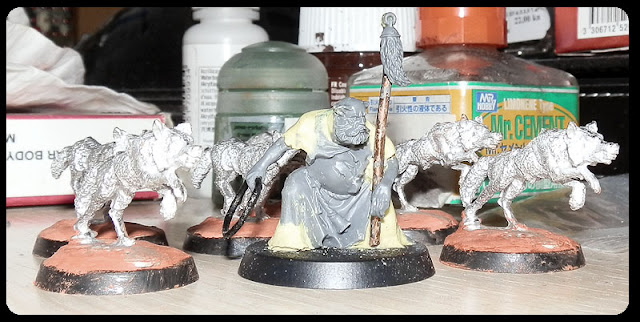 |
| The wolf herdsman has the body of a Skaven Plague Priest from the Plague Furnace kit, head and wolf tail decoration from a Space Wolf, arms from The Hobbit Goblins, carved head on the tip of his staff is from some dwarf's helmet (originally a dragon head, I believe). The staff's shaft is a length of brass rod. The six wolf miniatures are Young wolves from Ral Partha. |
Design choices
At
first I meant to dress the character in dirty and torn civilian
clothes, but he ended up in a frayed monk's habit when I discovered that
Skaven body in my bits box. He needed to have a bushy beard, so I
picked this Space Wolf head. It also sports a hairstyle that looks a lot
like the tonsure, which is associated with Catholic monks. The props
that were a must include on the figure are the staff and the hoop. The
staff was meant to be a shepherd's crook, but I went in a different
direction after I decided to add a wolf's tail on it to visually tie him
in with his wolves better. After that I thought I might as well put a
carved wolf head on the top. For the hoop I went with the simplest
possible look.
For variety's sake the pack will in the future be joined by a few more wolves which will be different sculpts.
* * *
Wilderness basing- how I do it
MarK asked me in the comments about my recent basing style and I promised a tutorial. So here it is for all of you.
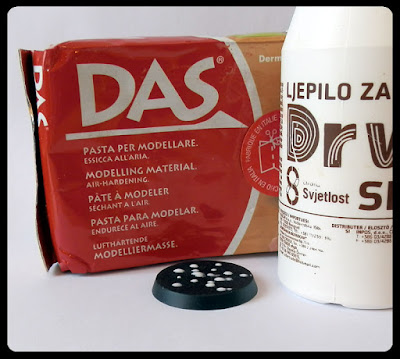 |
| STEP I: If my composition requires it, I first build up some height with DAS clay. When you do this make sure to put some PVA underneath to help it stick to the base. When it cures it should be durable enough (has always been for me). This can also be done with Milliput if you are afraid DAS is not strong enough. |
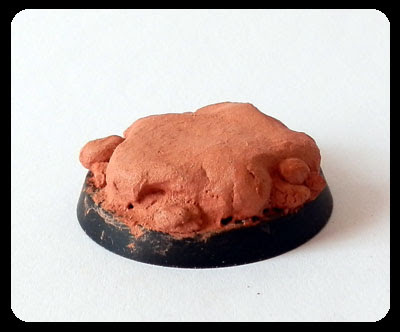 |
| I sculpted a rock for the wolfherd to stand on. DAS comes in white and terracotta. The colour is irrelevant because it gets painted over anyway. |
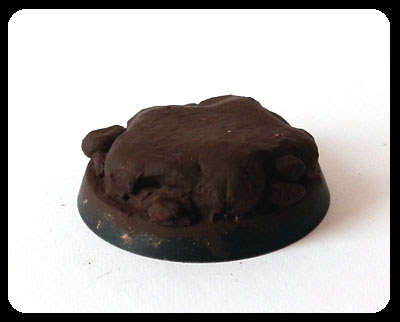 |
| STEP II: After priming I paint the entire thing dark brown. |
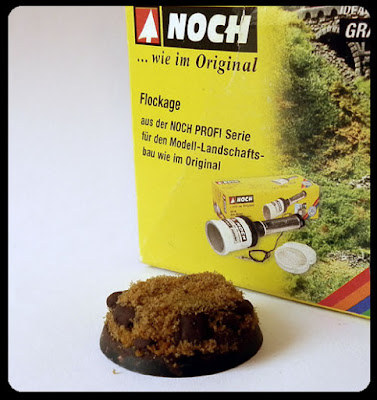 |
| STEP III: When the paint is dry I cover everyting that won't be a visible rock in PVA and dip it in Noch flockage. |
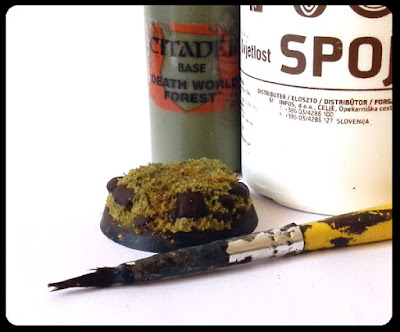 |
| STEP IV: Next step is making a PVA and water mix and covering the flock with it. The flock will soak it in and when it's dry it will become more durable. While this is still wet I take watered down green paint and wash patches of flock that colour. This adds some variation. Or if you have more than one colour of flock you can just use more than one colour in step III and skip the paint. |
 |
| STEP V: When step IV is completely dry I take an old brush and stipple the flocked areas with Zandri Dust. These highlights give the base more depth. |
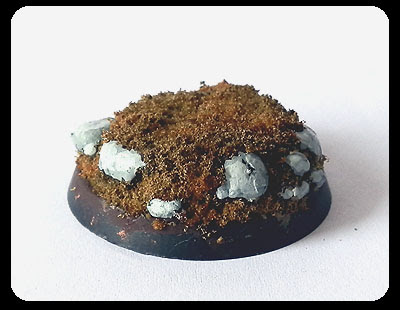 |
| STEP VI: The rocks. Dawnstone layered with Celestra Grey. |
 |
| STEP VII: Black wash and brown wash on the rocks. |
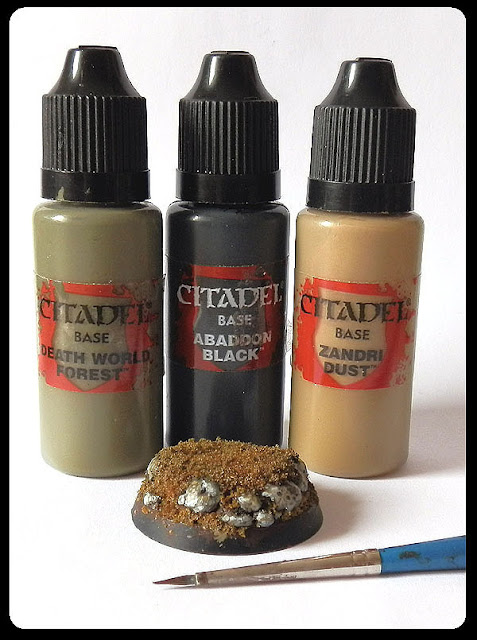 |
| STEP VIII: I add highlights here and there with light grey, almost white. And finally paint specks of moss and lichen. |
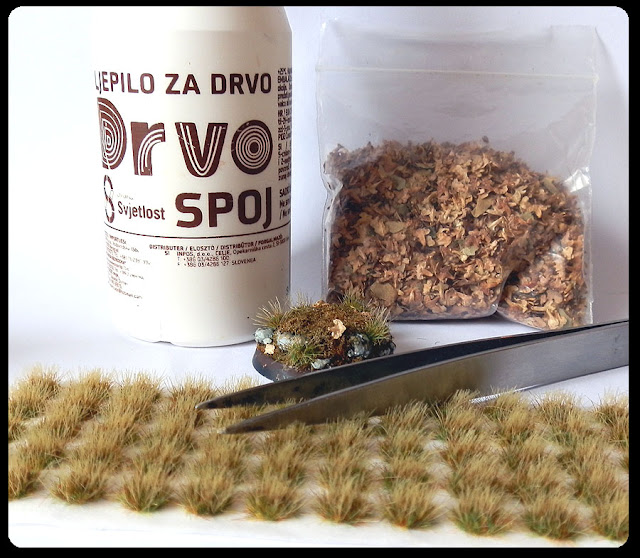 |
| STEP IX: After this I usually finish off with some tufts and leaves. Handled with tweezers and glued with PVA. Just a tip: don't forget that grass tufts can be shaded with washes and highlighted with a brush, too. |
There are tons of basing products out there. One can play around and experiment. Not necessarily use all of it on one base - less is more. This is a part of my current basing arsenal:
- NOCH static grass. Different lengths and shades. I used this a lot on my Wilderness scenery.
- NOCH flock. Versatile stuff. Used in the above tutorial.
- Flowers from Kellerkind Miniaturen.
- Citadel static grass.
- Pablo el Marques static grass. Great thing about this brand, apart from a wide palette of available colours, is that they sell grass in packs as small as two grams. Most convenient.
- Mini dry leaves. Come from birch seed pods. Can be bought or collected from nature.
- Aetztech etched brass ferns.
- Gamer'sGrass tufts. I use them a lot. Variety of colours, tuft sizes and fibre lengths to choose from. There are moss patches and flowers, too.
- Ivy and tree leaves from Mini Natur. There is also a pack of their moss tufts in that pile of blisters.
- Natural tree roots I harvested myself.
All these things are good for bases as well as scenery and dioramas. And there are still many things I want to try out but haven't got round to purchasing yet. What do you guys use for your bases?


















That pack look great. Is the Herder considered an evil figure in your folklore or more a manifestation of the forces of nature?
ReplyDeleteI've never seen them explicitly described as evil. They don't actively go around and seek to harm people. But since wolves are not animals people with cattle like much, I suppose their herders were not regarded as very positive figures either.
DeleteCreatures of old rural folklore are not so much defined in terms of universally good vs universally evil, as they are in terms of harmful for one's own community vs beneficial for it. Many can be both. Some are neither.
In folklore they generally appear as either benevolent or malevolent, yet not wholly good or bad. I think that the concepts of absolute good, verse absolute evil only came into being after the Christianization of Europe.
DeleteBefore, in the roman empire such concepts were common.
DeleteThanks I figured that he would reflect nature in regards to being both benvalent and threatening! Thanks for the clarification.
DeleteMonstrous Births sounds amazing, I wish I could attend to it. Thank you so much for the tutorial, I will grab some air drying clay.
ReplyDeleteThank you Florian!
DeleteVery nice. The washes look very good on the wolves. The basing technique is very useful: I might give that a try. Have you ever seen The Company Of Wolves, by the way? It's got a sort of Grimm's Tales look that reminds me of your work.
ReplyDeleteThanks Toby! I know the movie. I see what you mean. :)
DeleteAmazing work! Love this folklore element. I also try to make some slavic demonology ghosts/demons.
ReplyDeletegreetings
Thanks! That's cool. I need to go take a look at those particular posts.
DeleteThat scruffy looking wolf-herder is just great, both as a folklore element, and as a miniature. The wolves are very well done too, which I can appreciate more than usual after my own efforts in that regard.
ReplyDeleteQuite enjoy the view of your basing materials. I have a bunch myself, but scattered about in various drawers, so they do not get used as thoughtfully as they ought.
Thank you! I have a drawer dedicated solely to basing and diorama materials but it inevitably ends up with the most commonly used stuff on top, and a bunch of things buried underneath which I forget I even have. I try to put things back in order every couple months...
DeleteI like very much the sights of local folklore you give in your work. Also, the tutorial for the bases seems very useful. Thanks!
ReplyDeleteThank you!
DeleteA very informative post, thanks!
ReplyDeletePerfect concept! :)
ReplyDeleteYou should create posts for each of your game sessions and write them as a story.
ReplyDeleteOh absolutely, that's the plan.
DeleteI'm rather envious of your gaming group.
ReplyDeleteBeautiful work Ana from concept through execution and thank you for showing us how you tackle your bases.
Thanks Dai! No problem, I'm always happy to share my methods.
DeleteWonderful!
ReplyDeleteThanks Alexander!
DeleteAwesome new miniatures!
ReplyDeleteThanks a lot for the tutorial, these bases really look nice!
You're welcome!
DeleteBeautiful work!
ReplyDeleteThanks Kym!
DeleteThank you very much for the mention! :-D
ReplyDeleteGlad you like my products
(Shared on facebook) ;-)
Thanks Pablo!
DeleteBrilliant post! I was planning to use DAS clay to sculpt a diorama and I hope you can help me with this question. What kind of primer did you use on the DAS clay? I was thinking of priming them with a lacquer-based primer (Tamiya Fine Surface Primer) and subsequently spray them with Tamiya synthetic lacquer paints but I'm not sure how DAS clay will react with non-acrylic paints.
ReplyDeleteI used acrylic spray.
DeleteI can't say I know how DAS would react to non-acrylics, but I don't think it would be any different. If you already own both the paints and the clay, make a test with a small piece of DAS to see if anything bad happens. Perhaps asking in a military modeller group or forum will get you your answer. They are more into lacquer based paints.
Best of luck with your project. :)
Thank you Ana! I have both acrylic as well as lacquer paints so I guess a bit of experimenting is in order. :)
DeleteAwsome idea. Thanks for sharing!
ReplyDelete